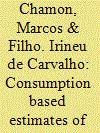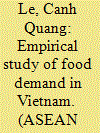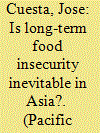|
|
|
Sort Order |
|
|
|
Items / Page
|
|
|
|
|
|
|
| Srl | Item |
| 1 |
ID:
133192


|
|
|
|
|
| Publication |
2014.
|
| Summary/Abstract |
This paper estimates the household income growth rates implied by food demand in a sample of urban Chinese households in 1993-2005. Our estimates, based on Engel curves for food consumption, indicate an average per capita income growth of 6.8% per year in 1993-2005. This figure is slightly larger than the 5.9% per year obtained by deflating nominal incomes by the CPI. We attribute this discrepancy to a small bias in the CPI, which is of a similar magnitude to the one often associated with the CPI in the United States. This result supports the view that Chinese price statistics are reliable. Our estimates indicate stronger gains among poorer households, suggesting that urban inflation up to 2005 in China was "pro-poor," in the sense that the increase in the cost of living for poorer households was smaller than for the average one.
|
|
|
|
|
|
|
|
|
|
|
|
|
|
|
|
| 2 |
ID:
085709


|
|
|
|
|
| Summary/Abstract |
This paper uses a linear approximation of Almost Ideal Demand System (AIDS) and extended AIDS models to investigate food consumption in Vietnam using the Vietnam Living Standard Survey (VLSS) in 2004. In particular, AIDS models are estimated to calculate income and price elasticities for three different components of food categories. Our results suggest that rice food and meat/fish are normal goods, while non-rice food is luxury. Household characteristics such as age, gender, and education do not appear to affect food consumption significantly, while urban/rural location is important. These results may give empirical evidence for policy-makers to design food policy in Vietnam.
|
|
|
|
|
|
|
|
|
|
|
|
|
|
|
|
| 3 |
ID:
143530


|
|
|
|
|
| Summary/Abstract |
This study analyzes the household food demand followed by projecting the future level of demand of selected food commodity groups in Pakistan. It uses Pakistan Panel Household Survey (PPHS) for the year 2010, conducted by Pakistan Institute of Development Economics (PIDE). The linear approximation/almost ideal demand system (LA/AIDS) model is used to estimate the demand elasticities, while a simple growth model is used for food demand projections. The empirical results reveal that food grains, pulses, ghee, sugar and vegetables are necessities, while milk and meat are luxuries. Pulses and vegetables, ghee and meat, milk and sugar are identified as gross complements on the basis of uncompensated cross-price elasticities. The uncompensated cross-price elasticities of food grains indicate the substitutive relationship between different food items, such as pulses, meat and vegetables. An increase in the household income will induce a substantial expansion in household demand for milk and meat products, but the consumption of these foods will decline if household size grew, ceteris paribus.
|
|
|
|
|
|
|
|
|
|
|
|
|
|
|
|
| 4 |
ID:
116523


|
|
|
|
|
| Publication |
2012.
|
| Summary/Abstract |
Most existing studies of food demand focus on economic factors, such as income and price. Physical factors which determine human energy intake requirement, given economic conditions, such as gender and age structures of the population as well as occupation, are usually not incorporated. While this is appropriate in the situation of a continuous, stable development of demographic structure, it might lead to biased result if drastic and irregular demographic changes have taken place. This paper provides a case study of China of the impact of demographic dynamics on the change of physical requirement and energy intake demand. The unique population pyramid in China, resulted from the big famine in the early 1960s and then the "One Child" policy" starting from the 1980s, has led to the irregular evolution of age groups and the consequent changes in the proportion of the "big-eaters". As a result, given food price and income, the very age structure of the population at the time affects the overall weighted energy intake level of the population significantly. Using household survey data ranging from year 1991 to 2009, the index of Adult Male Equivalent Scale (AMES) is constructed to reflect the varying per capita physical requirement resulted from the demographic dynamic over the years in China. The AMES index, together with food price and income, has been applied to the per capita energy intake model. The empirical results show that the AMES index has statically strong impact on per capita energy intake, and the inclusion of the AMES index into the model has improved the model fitness. This finding sheds light on a possible way for improvement in projecting China's food demand in the future by incorporating the country's changing demographic factors.
|
|
|
|
|
|
|
|
|
|
|
|
|
|
|
|
| 5 |
ID:
135066


|
|
|
|
|
| Summary/Abstract |
This article questions two widely accepted claims on long-term food insecurity in Asia, the world's (heterogeneous) region with the largest number of undernourished individuals. The first claim is that food production may not grow as fast as the pace of population growth in Asia, which will reach 5 billion by 2050. The second claim is that an unstoppable emergence of a middle class in Asia will dramatically change the composition of food demand. On the first claim, the region's contribution to high and volatile international food prices is well known, but Asia's potentially positive contributions toward future price uncertainty and productivity growth are much less cited. On the second claim, the changing composition of future food demand in the region will depend on the extent that poverty reduction effectively leads to middle class expansion, which it is not an automatic process, and its extent still remains to be seen. Past evidence teaches us that poverty reduction on its own will not do the job of eradicating hunger, nor will only increasing food production. The jury is still out, but doomsday predictions are not necessarily justified.
|
|
|
|
|
|
|
|
|
|
|
|
|
|
|
|
|
|
|
|
|